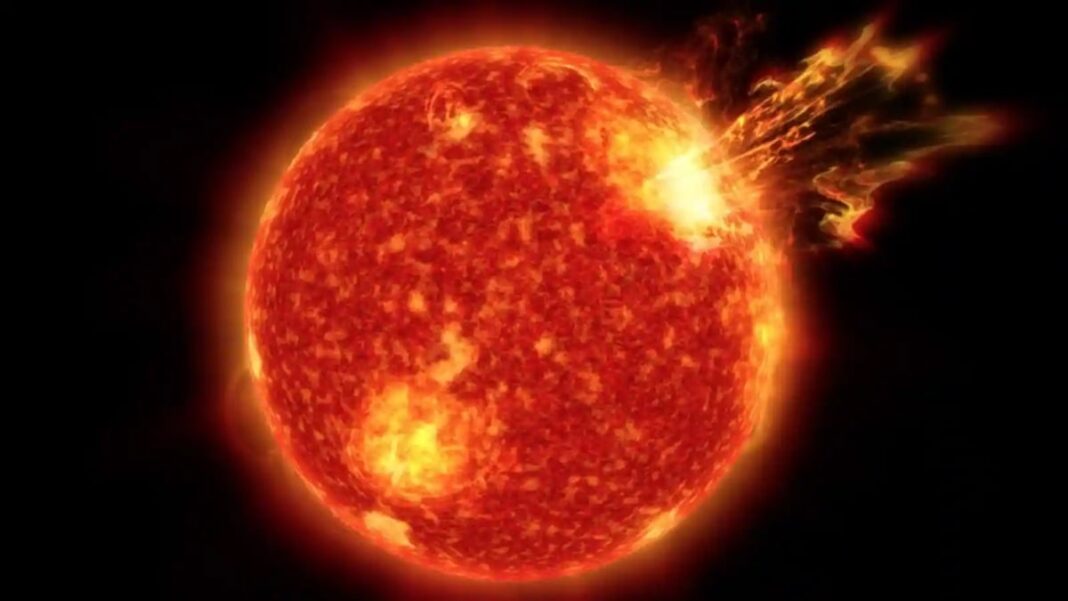A massive X-class solar flare, the strongest classification of its kind, erupted from sunspot region 3912 at 4:06 a.m. EST on December 8, as per reports from the National Oceanic and Atmospheric Administration (NOAA). The solar event, accompanied by a coronal mass ejection (CME), caused radio blackouts in southern Africa, where the region was exposed to the Sun at the time. Experts suggest the CME may graze Earth, resulting in minor geomagnetic disturbances.
The Solar Flare that Shook the Earth: A Review
The Story So Far: Imagine a world where the Sun is not just a source of light and warmth but also a powerful force capable of disrupting our very existence. This is precisely what happened when a massive X-class solar flare erupted, sending shockwaves through Earth’s atmosphere and causing chaos in southern Africa. But what does this mean for our planet and its inhabitants?
Radio Blackouts Observed Across Southern Africa
The intense flare ionised Earth’s upper atmosphere, impacting high-frequency radio communications. NOAA’s Space Weather Prediction Center reported that the ionisation led to increased atmospheric density, absorbing radio signals and weakening long-distance communication. Southern Africa bore the brunt of this disruption, facing notable blackouts due to direct exposure to the Sun during the flare’s peak.
Expert Insight on Solar Impact
Renowned Space Weather Physicist Dr Tamitha Skov shared her insights on the solar event, highlighting that Earth is likely to experience limited effects from the CME. She explained that the solar storm will graze Earth to the west, with fast solar wind streams potentially deflecting it even further west. This could result in mild impacts by midday on December 11, offering a glimmer of hope amidst the chaos.
Understanding Solar Flares and Their Effects
Solar flares, classified into categories A, B, C, M, and X based on their strength, are intense bursts of electromagnetic radiation originating from the Sun. X-class flares, the most powerful of them all, have the potential to severely disrupt satellite operations and communication systems. This recent eruption serves as a reminder of the active phase in the current solar cycle, hinting at the likelihood of similar events in the future. While Earth remains largely unscathed by this particular flare, experts stress the importance of monitoring solar activity to safeguard our technological infrastructure.
Conclusion
In the grand scheme of the universe, a solar flare may seem insignificant, but its effects on Earth can be profound. As we navigate through these celestial events, it becomes clear that our planet is intricately connected to the cosmos in ways we are only beginning to understand. The solar flare serves as a reminder of the delicate balance between our world and the vast expanse of space, urging us to remain vigilant and prepared for whatever the universe may throw our way.
Frequently Asked Questions
- What is the significance of an X-class solar flare?
X-class solar flares are the most powerful type, capable of disrupting communication systems and satellite operations on Earth. - How do solar flares impact radio communications?
Solar flares ionise Earth’s upper atmosphere, affecting high-frequency radio signals and causing disruptions in long-distance communication. - Who is Dr Tamitha Skov, and why is her insight valuable?
Dr Tamitha Skov is a Space Weather Physicist known for her expertise in solar events. Her insights help us understand the potential impacts of solar storms on Earth. - What are the different categories of solar flares?
Solar flares are classified into categories A, B, C, M, and X based on their strength, with X-class flares being the most powerful. - How can we mitigate the risks posed by solar flares to our technological infrastructure?
Monitoring solar activity and staying informed about potential solar storms can help us prepare and protect our communication systems and satellites. - Why is it important to study solar flares and their effects?
Studying solar flares helps us better understand the Sun’s behavior and its impact on Earth, allowing us to mitigate potential risks and protect our planet. - What role do fast solar wind streams play in deflecting CMEs?
Fast solar wind streams can potentially deflect coronal mass ejections (CMEs), altering their trajectory and minimizing their impact on Earth. - Are there any long-term consequences of solar flares on our planet?
Solar flares can have short-term impacts on Earth, such as disruptions in communication systems, but long-term consequences are minimal. - How often do X-class solar flares occur?
X-class solar flares are relatively rare but can occur during active phases in the solar cycle, highlighting the dynamic nature of our Sun. - What precautions should we take during a solar flare event?
During a solar flare event, it is advisable to limit exposure to high-frequency radio signals, monitor updates from space weather prediction centers, and prepare for potential disruptions in communication systems.Tags: solar flare, space weather, Earth’s atmosphere, solar storm, X-class flare, geomagnetic disturbances, radio blackouts, solar cycle.

